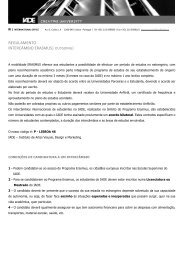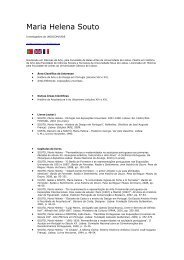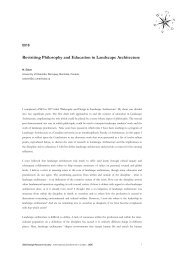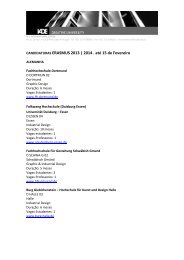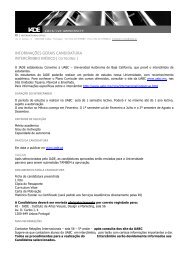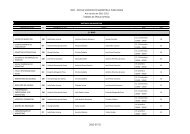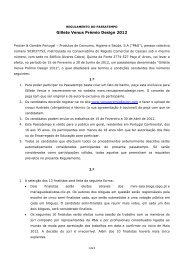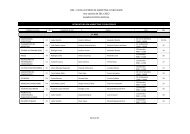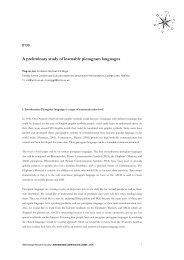0053 Conventions of Typography Related to Traditional Poetry - IADE
0053 Conventions of Typography Related to Traditional Poetry - IADE
0053 Conventions of Typography Related to Traditional Poetry - IADE
Create successful ePaper yourself
Turn your PDF publications into a flip-book with our unique Google optimized e-Paper software.
There is also a variation in terms <strong>of</strong> space devoted <strong>to</strong> poetry. Sometimes whole sections, sometimes paragraphs<br />
and sometimes only few lines are related <strong>to</strong> poetry. At times, a whole section is devoted <strong>to</strong> poetry, yet at other<br />
times references <strong>to</strong> poetry are spread throughout the book. For instance, De Vinne (1902 and 1904) points out<br />
general <strong>to</strong>pics relating <strong>to</strong> composition such as capital letters, running heads and breaking lines, yet only<br />
occasionally includes the genre <strong>of</strong> poetry. He does not mention poetry within every <strong>to</strong>pic, but only in cases<br />
where he considers it important <strong>to</strong> demonstrate its special characteristics. <strong>Poetry</strong> is mentioned in Williamson<br />
(1956) in a chapter that deals with principles <strong>of</strong> text design. He devotes few pages <strong>to</strong> this. McLean (1980)<br />
devotes one page and one illustration <strong>to</strong> issues related <strong>to</strong> setting poetry in his chapter about the parts <strong>of</strong> a<br />
book. Bringhurst (1992) discusses verse with reference <strong>to</strong> poetical quotations, but he also recommends that the<br />
typographer must be aware enough <strong>to</strong> make the units <strong>of</strong> verse (the stanza and its articulation) clear <strong>to</strong> the<br />
reader. Tschichold (1967:46) is another writer who mentions poetry only briefly: he devotes few lines <strong>to</strong> this.<br />
In his opinion: ‘poetry is only perfectly set when it is set like a list’ (which it can be assumed <strong>to</strong> mean that it is<br />
aligned on the left). He explains that:<br />
It is no accident that verse is set <strong>to</strong> align on the left. If lines <strong>of</strong> verse were set<br />
symmetrically centred, they would be much harder <strong>to</strong> read because the eye would<br />
continually search for start <strong>of</strong> the lines. (Tschichold 1967:44)<br />
In this brief comment, Tschichold shows that he prefers <strong>to</strong> align text on the left rather than centrally, selecting<br />
from two options only. However, he is ignoring the use <strong>of</strong> indentation, which is a commonly found third<br />
option for setting line beginnings in poetry.<br />
Butcher (1992) has included a chapter entitled ‘Literary material’ in which she merely mentions poetry <strong>to</strong>gether<br />
with other <strong>to</strong>pics such as quotations, plays, anthologies and collections <strong>of</strong> essays. She does not mention poetry<br />
in the ‘Special subjects’ chapter, as she does with music and law. The Chicago manual <strong>of</strong> style discusses six <strong>to</strong>pics<br />
relating <strong>to</strong> poetry in three paragraphs within a chapter section entitled ‘Text other than prose’. When Simon<br />
(1945) wrote about the setting <strong>of</strong> a text, he devoted few pages <strong>to</strong> text and examples. Ritter (2002) devotes one<br />
page <strong>to</strong> the setting <strong>of</strong> poetry and four more <strong>to</strong> quotations, punctuation, ellipses, sources, foot- and end-notes<br />
and prosaic notations. Skillin and Gay (1974) devote one page <strong>to</strong> positions, indentation and scansion,<br />
discussing issues relating <strong>to</strong> lay out, rhymed lines and symbols <strong>to</strong> indicate stressed syllables. Hochuli and<br />
Kinross (1996:52) devote few pages <strong>to</strong> poetry; those which are included are heavily illustrated and focus on<br />
layout, including centring the poem visually on the page and balancing facing pages. It is a brief text; however,<br />
they specify that ‘line-breaks, indents, line space, lines that begin with capitals or with lowercase will be<br />
stipulated by the author and respected by the typographer’. This quotation shows which features they consider<br />
<strong>to</strong> be characteristic <strong>of</strong> poetry.<br />
Similarities in suggestions and rules<br />
Despite the differences found in these works, the similarities which persist among these sources are<br />
meaningful. The Chicago manual <strong>of</strong> style, McLean and Williamson agree with Oliver Simon in his Introduction <strong>to</strong><br />
typography (1945) that the choice <strong>of</strong> typeface provides a solution <strong>to</strong> the problem <strong>of</strong> turnover lines because<br />
smaller or narrow typefaces allow a verbally longer line. Simon again is not alone in suggesting that typeface<br />
influences the appearance <strong>of</strong> the rhythm <strong>of</strong> the poem. Williamson (1956) and others support this view. Simon,<br />
2006 Design Research Society . International Conference in Lisbon . <strong>IADE</strong> 6





